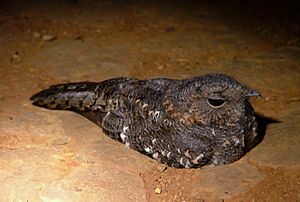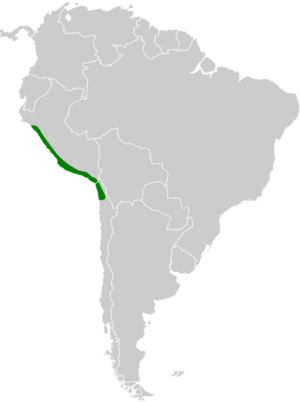Tschudi's nightjar facts for kids
Tschudi's nightjar or lesser band-winged nightjar (Systellura decussata) is a cool bird that belongs to the nightjar family. You can find this bird living in Chile and Peru.
Quick facts for kids Tschudi's nightjar |
|
|---|---|
 |
|
| Band-winged Nightjar (Caprimulgus longirostris) | |
| Conservation status | |
| Scientific classification | |
| Genus: |
Systellura
|
| Species: |
decussata
|
 |
|
| Synonyms | |
|
|
Contents
What Does Tschudi's Nightjar Look Like?
Tschudi's nightjar is about 20 to 21 centimeters (8 to 8.3 inches) long. That's about the length of a standard pencil!
Male birds usually weigh between 28.5 to 35 grams (1 to 1.2 ounces). Female birds are a bit heavier, weighing around 32 grams (1.1 ounces).
This bird is mostly grayish-brown with small black spots.
- Males have a wide, reddish-brown collar on the back of their neck.
- They also have a small white patch on their throat.
- You can see white bands on their wings and white tips on their tails.
- Females have a yellowish-brown throat.
- Their wing bands are also yellowish-brown.
- Unlike males, females usually don't have white on their tails.
Where Does Tschudi's Nightjar Live?
You can find Tschudi's nightjar along the western coast of Peru and in the very northern part of Chile.
These birds like to live in dry areas, especially near the coast and in the foothills. They prefer open spaces, clearings in forests, and the edges of wooded areas. You might even spot them in cities, like Lima, Peru!
In Peru, they live from sea level up to about 1,300 meters (4,300 feet) high. In Chile, they have been seen even higher, up to 3,350 meters (11,000 feet).
How Does Tschudi's Nightjar Behave?
What Does It Eat?
Scientists don't know much about what Tschudi's nightjar eats or how it finds its food. It's still a bit of a mystery!
Reproduction and Life Cycle
It's believed that Tschudi's nightjar lays its eggs and raises its young from November, or even earlier, until January. Beyond that, not much is known about their breeding habits.
What Sounds Does It Make?
The song of Tschudi's nightjar is a loud series of clear, slightly buzzing "cueeo" notes. When it's alarmed or feels threatened, it makes a slightly squeaky "wick" sound.
Is Tschudi's Nightjar in Danger?
The IUCN (International Union for Conservation of Nature) has looked at Tschudi's nightjar and decided it is a species of "Least Concern." This means they are not currently worried about it becoming endangered.
The area where these birds live is very large, at least 200,000 square kilometers (77,000 square miles). Even though we don't know the exact number of these birds, their population seems to be stable.


